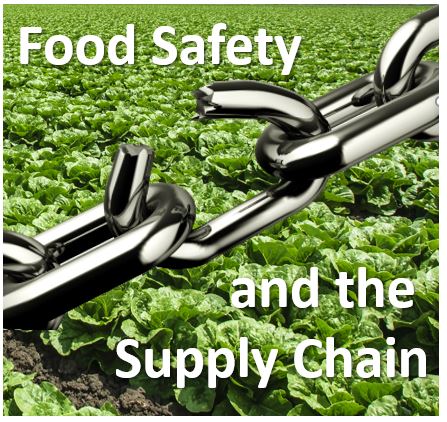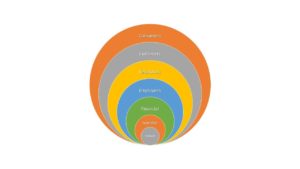Recently, I saw the Produce Marketing Association’s Dr. Bob Whitaker present on food safety and the supply chain. Dr. Bob, as he’s affectionately known, was the opening keynote speaker at the Salinas AgTech Summit in March and also the closing keynote speaker at this month’s PMA TechKnowledge conference. At both events, his message was about the need to rethink how we, as an industry, address food safety challenges and the supply chain.
For me to summarize his presentations would be challenging as they were quite comprehensive and eloquent. Fortunately, Dr. Whitaker recently posted a blog on his LinkedIn page that summarizes his thoughts, Produce Safety Insights Can Come From Unusual Places. (I will quote from his blog using italics.)
The Food Safety and Supply Chain Relationship
As most everyone in the industry is aware, over the past 18 months or so the industry has experienced three E. coli outbreaks related to romaine lettuce. Everyone in the industry takes these outbreaks very seriously but, having three outbreaks in a such a close time frame could be seen to indicate that we need to come up with new ways of addressing these situations.
In many cases, the challenges we face when dealing with food safety in the supply chain involves first identifying what caused the issue and then trying to work back through the supply chain to find the source. If we’re able to identify the source, we then have to figure out where all of the food from that source was distributed. Sometimes this can take weeks or months and, too often, the food has already been consumed.
It’s challenging to be sure, but, because public health is involved, it has to be a priority for the industry. Saving lives and preventing illnesses is the first priority. But, there’s also an environmental and financial cost. For example, when an issue was identified with romaine, everyone including retailers, restaurants and consumers, were instructed to destroy or toss it. Because we aren’t able to identify specifically impacted lots, tons of perfectly safe romaine ended up in landfills, creating greenhouse gasses and huge losses for the industry.
Rethinking Food Safety and the Fresh Food Supply Chain
Dr. Whitaker’s blog suggests that it’s time we rethink how we address food safety for the fresh food supply chain. In his blog, he writes:
One of the first things our industry always does following a produce safety crisis is to look inward to try to solve the problem. If the problem involves a production practice at the farm level, then usually a group of growers, maybe some technical experts and likely a commodity group or a trade association come together to hash out a solution to address the problem. At this point, it feels natural; as I have been part of those efforts over the years.
But there is also something else that happens. As time passes, the will to make significant changes peters out. We settle back into the routine, we resist change and certainly changes that disrupt long held production or business practices and ones that bring additional costs to production and distribution that seemingly cannot not be recouped in the marketplace. That’s not to say that guidances are not written and educational materials developed to help us all do better. If you look back, most of these efforts been developed with more of an eye towards preserving what we are already doing as opposed to questioning the acceptability of those practices given the risks they might represent.
Dr. Whitaker suggests a different approach he notes is used by marketers to define a “sandbox” of everyone that should be involved in addressing this challenge. In other words, we should define who want to talk to and how to develop messages for each participant in the audience to understand.
Dr. Whitaker continues:
I got to wondering, what if we defined our “sandbox” when we faced a produce safety crisis? This would allow us to identify who needed to be convinced that our solutions and practices really addressed the problem. Would our will to enact and sustain effective changes then be more prolonged? If we really examined the complexities of a produce safety incident where:
- consumers are made ill,
- people can suffer life-altering injury and even death,
- companies that have no connection to the cause of the illness outbreak but are caught up in the commodity-wide consumer advisories that seem to be more and more common, and
- people who depend on the industry for employment find themselves out of work because there are no markets for their products
maybe the incentive to make hard decisions on produce safety might prevail.
The figure (Dr. Whitaker’s produce safety “sandbox”) uses a cluster of concentric circles expanding outward as the size of the audience that needs to be addressed grows by size and complexity.
Any new approach that is developed to manage a pathogen contamination hazard needs to be based on the risk that hazard poses to public health, leverage our best science, and be executable in our production environments. That is not to say that new approaches are easy, comfortable, cost neutral or even 100% effective. But they do have to be explainable to all the stakeholders in our “sandbox” and more importantly defensible.
He then defines who should be in this sandbox? For the sake of brevity, I’m paraphrasing Dr. Whitaker’s words:
- Producers — growers, shippers, processors, transportation, ingredient suppliers, etc.
- Scientists — the subject matter experts — that are positioned to understand the science that should be driving produce safety practices.
- Banks and insurance companies that enable the industry.
- Employees as it is important for them to understand what is being done to prevent future safety issues with our products and to even gather input from them to see what ideas they might bring to the table.
- The regulatory community as they are our partners and they cannot solve our produce safety problems.
- Our customers (in the supply chain, e.g. grocers, restaurants, etc.) need to be a primary target of communications. We need to be transparent in the science we are proposing to employ, the changes to our operations and our plans for execution. Recent outbreaks clearly point to a lack of traceability in the “final mile” as FDA describes it, where critical producer, lot number and date information is not available at the point of sale to enable an effective traceback. Produce safety is a supply chain issue, not just a producer issue. Both suppliers and buyers will need to invest in traceability systems as a critical piece of their overall produce safety programs. Certainly, the losses incurred by both in terms of supply chain disruption, loss of consumer trusts and financial impact can be used to balance any increased costs associated with traceability.
- Consumers… all the earlier stakeholders in our “sandbox” must understand what is being done and why it is going to be successful so we can all be confident in our messaging to consumers. Short-cuts and half-measures that beget yet another incident will only erode consumer trust more.
Rethinking Traceability for Food Safety in the Supply Chain
I want to emphasize part of point six above:
Recent outbreaks clearly point to a lack of traceability in the “final mile” as FDA describes it, where critical producer, lot number and date information is not available at the point of sale to enable an effective traceback. Produce safety is a supply chain issue, not just a producer issue. Both suppliers and buyers will need to invest in traceability systems as a critical piece of their overall produce safety programs.
There’s been a lot said about this problem but sometimes it seems we’re not making much in the way of progress. Blockchain is often cited as the cure to the problem and, most likely, it will be a part of the cure but, as Dr. Whitaker points out, often the data (e.g. the producer, lot number and date information) is incomplete or unavailable.
This is where IoT sensors can play a significant role. Not only can IoT sensors be implemented to reduce food waste, if we apply sensors to each pallet of produce, beginning at harvest, we can also automatically and autonomously build a traceability record for each pallet as it moves through the supply chain to the retailer or restaurant.
This methodology can be applied for field harvested produce, such as strawberries or romaine hearts, where there is a continuous path from field to store and also for processed produce, such as packaged lettuce mixes. For processed produce, we can track and manage pallets from the field to the processor and then link that data to the packaged produce from the processor to the customer.
The data collected by these sensors can be autonomously transmitted to cloud based applications to create a record for traceability that includes harvest data, produce condition data, processing and testing information. This can be controlled and accessed by participants throughout the supply chain.
A Sense of Responsibility
Dr. Whitaker summarizes the goals of the sandbox approach and notes that, by including all stakeholders and defining a plan, it places a higher sense of responsibility for those of us involved in the fresh food supply chain when it comes to food safety.
Describing our “sandbox” has a sobering effect. It places a higher sense of responsibility on us all when we consider produce safety programs. It should fortify the will to identify and accept the changes that need to be made. Taking a broader view should help manifest the courage it takes to make the difficult changes in our operations.
Changes in our operations could be building in and prioritizing actions to address cross contamination hazards from ag water, to soil amendments, to the proximity of animal feeding operations and the efficacy of our sanitation practices along the supply chain.
The diagram also points to the responsibilities each group has to one another; producers to buyers and buyers to producers, producers to regulators and regulators to producers, etc. We are all linked together under the umbrella of produce safety.
I wonder if we thought about our “sandbox” and the constituents in our sandbox, if we would spend so much time questioning the minutia of how many samples to take or which organism we should test for and ask a different question: what must be done to protect my business and my customers?
Produce safety initiatives to improve our practices cannot ignore science and even common sense and devolve into efforts to protect the status quo or provide safe harbor for the weakest among us. The one lesson we should have learned by now is that a single operator or even a single event can bring down an entire segment of the produce industry and impact all those in our “sandbox”.
Throughout my career in the produce industry, the often-repeated dogma that we cannot “market” based on food safety has largely prevailed. I have always appreciated the sentiment in that belief though I can see cracks beginning to form in that principal. One thing I am starting to believe in is that we have much to learn from our marketing brethren in terms of understanding how what we do in produce safety needs to be communicated and understood by all those in our “sandbox.” There is simply too much at stake if we seek to recapture the trust we need to build in our products.
We’re very fortunate to have individuals like Dr. Whitaker at PMA and Dr. Jennifer McEntire at United Fresh who are vigilant about food safety and constantly strive to improve our industry. I encourage you to read Dr. Whitaker’s complete blog post and follow him and Dr. McEntire on LinkedIn.



